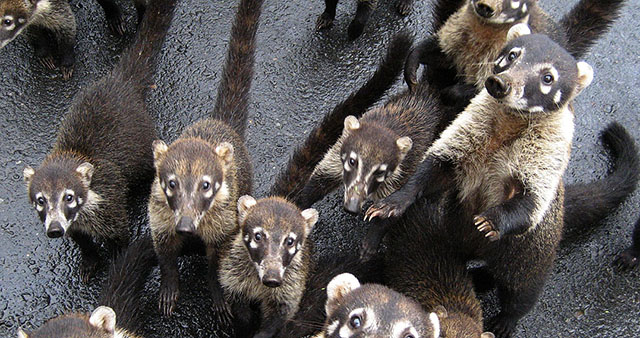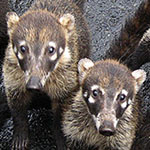- Home
- Accommodation
- Activities
- Area Info
- Maps
- Photo Galleries
- Real Estate
- Travel
Coati
Spanish Name: Pizote
Height/Weight: Adult males generally weigh 6 kg, and are 1.1 to 1.2 m long with a tail 0.500 to 0.6 m long; females are smaller.
Average life span: The average life span of a coati is 7-8 years in wild and around.
Habitat: The coati lives in a range of forests, from temperate oak and pine forests to deciduous and lowland tropical rain forests. It is at home even in deserts and savannas.
 Coatis are available mostly found in South America, all through Central America and the southern United States. They are commonly seen in the Guanacaste province of Costa Rica. They can also be regularly spotted by visitors at the Manual Antonio National Park, Cahuita National Park and around the Arenal Volcano. They can also be seen at Hacienda Solimar, Corcovado Lodge Tent Camp, Wilson Botanical Garden and Monteverde area. Coatis are quiet common in Costa Rica and Montezuma, found in ranges from hot and dry to humid rainforests or even mountain slopes, including bushy areas and grasslands. They can be easily seen in all part of Costa Rica and the countries national reserves. Visitors in Montezuma can see the scooting around near trees or bushy hiking trails. Coatis can also be spotted in most rainforest lodges and hotels housed inside Costa Rica’s forests. They will come to greet visitors in the morning and will often be seen eyeing their food and sometimes even asking for it.
Coatis are available mostly found in South America, all through Central America and the southern United States. They are commonly seen in the Guanacaste province of Costa Rica. They can also be regularly spotted by visitors at the Manual Antonio National Park, Cahuita National Park and around the Arenal Volcano. They can also be seen at Hacienda Solimar, Corcovado Lodge Tent Camp, Wilson Botanical Garden and Monteverde area. Coatis are quiet common in Costa Rica and Montezuma, found in ranges from hot and dry to humid rainforests or even mountain slopes, including bushy areas and grasslands. They can be easily seen in all part of Costa Rica and the countries national reserves. Visitors in Montezuma can see the scooting around near trees or bushy hiking trails. Coatis can also be spotted in most rainforest lodges and hotels housed inside Costa Rica’s forests. They will come to greet visitors in the morning and will often be seen eyeing their food and sometimes even asking for it.
 The white-nosed coati, is one of Costa Rica’s 200 mammal species, and is often confused with a raccoon or house cat, as it is almost similar in appearance. Coati fur color is usually reddish-brown to deep brown. Their heads are lengthy and slim with a pointed snout for picking up insects from the ground. Though color variations are common among coatis, many coatis have white or cream hued rings around their eyes, snout and tails. Coatis can weigh about ten pounds, and their stout legs and sharp claws turn them into dexterous climbers. Coatimundis are diurnal i.e. as a usual pattern, they are more active during the day and seek the refuge of trees at night.
The white-nosed coati, is one of Costa Rica’s 200 mammal species, and is often confused with a raccoon or house cat, as it is almost similar in appearance. Coati fur color is usually reddish-brown to deep brown. Their heads are lengthy and slim with a pointed snout for picking up insects from the ground. Though color variations are common among coatis, many coatis have white or cream hued rings around their eyes, snout and tails. Coatis can weigh about ten pounds, and their stout legs and sharp claws turn them into dexterous climbers. Coatimundis are diurnal i.e. as a usual pattern, they are more active during the day and seek the refuge of trees at night.
The coati’s breeding period begins during the rainy season when food is available in abundance. In some areas of Costa Rica, the coati breeding is at its peak between January- March while in others it happens more in October to February. Females reach their sexually maturity at the age of two, while males mature at the age of three.
An adult Coati male is allowed to makes its way into group of females at the onset of the breeding season, which eventually leads to mating after he chooses his prospective mate. Post mating, the pregnant females move away from their group, make a nest on a tree and have a gestation period of around 11 weeks. After six weeks of birth, the Coati females and their infants join the group again. About 3-7 kits are born at a time. Baby coatis are tiny (3 ounces) and rely on their mothers until they are about six weeks old. Young coatis are weaned till four months. In general, these mammals are extremely playful and the young ones are always up to mischief.
The Coati is primarily omnivores. Its diet comprises a combination of ground rubbish, foliage, invertebrates and some variety of fruits, eggs, and insects. Due to excessive human presence and tourism activities, the coatis in Costa Rica are now accustomed to having people around them and are even known to and are now known to plead for food. They also have known to ransack campsites for food, which is why tourists are extremely wary of these mischief mongers and boisterous creatures.
The white-nosed coatis are carnivorous, but a few will also consume plants and scavenge for human discarded food which is why they are also counted under the scavenger category. Adult males generally hunt and forage alone, though the females, the young ones and the yet to be sexually developed males will form groups. White-nosed coatis are also known to communicate socially, generally using vocalizations to communicate with each other. Mother coatis often leave their cubs with other females while they go in search of food. The young cubs are usually very active, noisy and playful, often spotted chasing each other up and down the trees.
The white-nosed coatimundi is not counted in the list of threatened species in Costa Rica. Owing to tourism and other commercial activities, humans often encroach on coati territory, forcing these active and clever creatures to fit their large population in small ranges. Their predators include ocelots, jaguarundis, jaguars, foxes and boa constrictors. There is a huge demand for these playful and amiable mammals in the pet industry.
More Information
http://costarica.com/wildlife/coatimundis/
http://www.costaricajourneys.com/coati-of-costa-rica/
http://a-z-animals.com/animals/coati/
Great Stuff

Clandestina Restaurant
My new favorite restaurant, Clandestina is not to be missed by food lovers staying anywhere near to Montezuma. Established in March 2015, Clandestina is the new kid on the block. The Oregon/Tico collaboration is a winner among locals and travelers alike, with artisan craft beers, made onsite by Butterfly Brewing Co. and delicious, exciting […]











